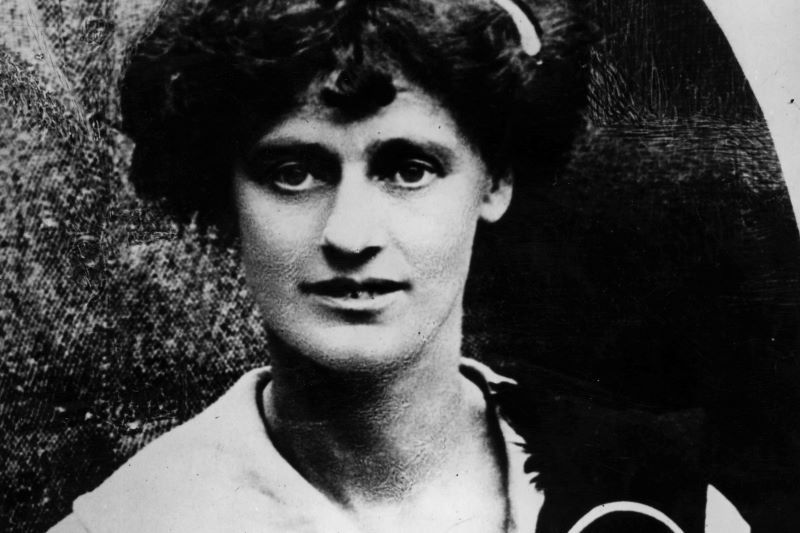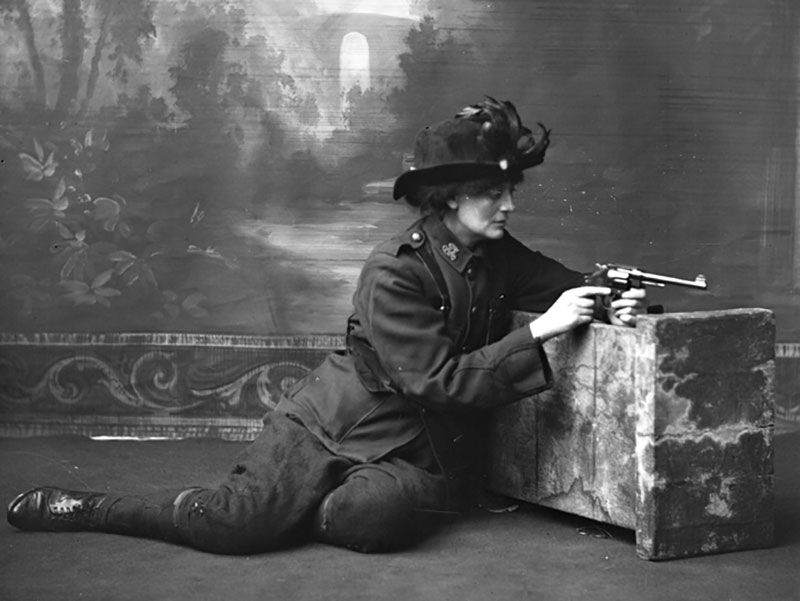Constance Markievicz also known as Countess and Madame Markievicz, was an Irish politician, revolutionary, suffragist, socialist, and the first woman elected to the British Parliament. She was also elected Minister for Labour in the First Dáil, becoming the first female cabinet minister in Europe. Markievicz She served as a Teachta Dála for the Dublin South constituency from 1921 to 1922 and 1923 to 1927. She was a Member of Parliament (MP) for Dublin St Patrick’s from 1918 to 1922.
Markievicz was one of the founding members of Fianna Éireann and the Irish Citizen Army, she took part in the Easter Rising in 1916, when Irish republicans attempted to end British rule and establish the Irish Republic. On 28 December 1918, she became the first woman elected to the UK House of Commons, but she did not take her seat in accordance with party policy. Instead, she and the other Sinn Féin MPs (as TDs) formed the first Dáil Éireann.
Biography
Constance Markievicz was born at Buckingham Gate in London in 1868. She was the elder daughter of Sir Henry Gore-Booth, 5th Baronet, an Anglo-Irish landlord, and Georgina, Lady Gore-Booth. Markievicz and her junior sister Eva Gore-Booth were said to have been inspired by their father, Sir Henry provided free food for the tenants on his estate, during the famine of 1879–80, to show deep concern for working people and the poor. Eva would become involved in the labor movement and women’s suffrage in Great Britain.
Markievicz attended the Slade School of Art in London, training to be a painter. It was at this time that she first became politically active and joined the National Union of Women’s Suffrage Societies (NUWSS). Later she moved to Paris and enrolled at the prestigious Académie Julian where she met her future husband, Casimir Markievicz, an artist from a wealthy Polish family.
The Markieviczes settled in Dublin in 1903 and moved into artistic and literary circles, with Constance gaining a reputation as a landscape painter. In 1905, Markievicz along with others, founded the United Arts Club, which was an attempt to bring together all those in Dublin with an artistic and literary bent. This however brought together many patriots and nationalists exposing Markievicz to revolutionary activities. Her contact with the revolutionary journals, The Peasant and Sinn Féin, which promoted independence from British rule, propelled her into action.
Early Political Participation
In 1908, Markievicz became actively involved in nationalist politics in Ireland. She joined the Irish Socialist Party Sinn Féin and Inghinidhe na hÉireann (‘Daughters of Ireland’), a revolutionary women’s movement. In the same year, Markievicz played a dramatic role in the women’s suffrage campaigners’ tactic of opposing Winston Churchill’s election to Parliament during the Manchester North West by-election, flamboyantly appearing in the constituency driving an old-fashioned carriage drawn by four white horses to promote the suffragist cause. Churchill lost the election to Conservative candidate William Joynson-Hicks, in part as a result of the suffragists’ dedicated opposition.
In 1909 Constance Markievicz founded Fianna Éireann, a nationalist scouting organization that instructed teenage boys in scouting. At Fianna’s first meeting in Dublin, on 16 August 1909, she was almost expelled on the basis that women did not belong in a physical force movement. She had drawn in Bulmer Hobson, who had earlier founded a less successful Boy Scout group in Belfast. He supported her, and she was elected to the committee.
She was jailed for the first time in 1911 for speaking at an Irish Republican Brotherhood demonstration attended by 30,000 people, organized to protest against George V’s visit to Ireland. During this protest, Markievicz handed out leaflets, erected great banners emblazoned Dear land thou art not conquered yet, participated in stone-throwing at pictures of the King and Queen, and attempted to burn the giant British flag taken from Leinster House, eventually succeeding.
The Easter Rising
Constance Markievicn joined the socialist Irish Citizen Army (ICA). As a member of the Citizen Army, she took part in the 1916 Easter Rising. She designed the Citizen Army uniform, composed its anthem, and was deeply inspired by the founder James Connolly.
Markievicz fought in St Stephen’s Green, where on the first morning —according to an alleged witness — she shot a member of the Dublin Metropolitan Police, Constable Lahiff, who subsequently died of his injuries. Other accounts place her at City Hall when the policeman was shot, only arriving at Stephen’s Green later. She however supervised the setting-up of barricades on Easter Monday and was in the middle of the fighting all around Stephen’s Green, wounding a British army sniper. The Stephen’s Green garrison held out for six days, ending the engagement when the British brought them Pearse’s surrender order.
Markievicz alongside other members of the ICA were arrested. At her court-martial on 4 May 1916, Markievicz pleaded not guilty to “taking part in an armed rebellion…for the purpose of assisting the enemy,” but pleaded guilty to having attempted “to cause disaffection among the civil population of His Majesty”. Markievicz told the court, “I went out to fight for Ireland’s freedom and it does not matter what happens to me. I did what I thought was right and I stand by it.” She was sentenced to death, but the court recommended mercy “solely and only on account of her sex”. The sentence was commuted to life in prison.
She was released from prison in 1917, along with others involved in the Rising, as the government in London granted a general amnesty for those who had participated in it.
Later Political Career
At the 1918 general election, Constance Markievicz was elected for the constituency of Dublin St Patrick’s, beating her opponent William Field with 66% of the vote, as one of 73 Sinn Féin MPs. The results were called on 28 December 1918. This made her the first woman elected to the United Kingdom House of Commons. However, in line with Sinn Féin abstentionist policy, she did not take her seat in the House of Commons.
Markievicz was in Holloway prison when her colleagues assembled in Dublin at the first meeting of the First Dáil, the Parliament of the revolutionary Irish Republic. When her name was called, she was described, like many of those elected, as being “imprisoned by the foreign enemy” (fé ghlas ag Gallaibh). She was re-elected to the Second Dáil in the elections of 1921.
Constance Markievicz served as Minister for Labour from April 1919 to January 1922, in the Second Ministry and the Third Ministry of the Dáil. Holding cabinet rank from April to August 1919, she became both the first Irish female Cabinet Minister and at the same time, only the second female government minister in Europe. She was the only female cabinet minister in Irish history until 1979 when Máire Geoghegan-Quinn was appointed to the cabinet post of Minister for the Gaeltacht for Fianna Fáil.
Markievicz left the government in January 1922 along with Éamon de Valera and others in opposition to the Anglo-Irish Treaty.
Death and Legacy
Constance Markievicz died at the age of 59 on 15 July 1927, of complications after two appendicitis operations, a dangerous surgery in the days before antibiotics. She had given away the last of her wealth, and died in a public ward “among the poor where she wanted to be”. She was refused a state funeral by the Free State government and was laid out in the Rotunda, where she had spoken at so many political meetings.
Thousands of the Dubliners who loved her lined O’Connell Street and Parnell Square to pass by her body and pay their respects to ‘Madame’. It took four hours for the beginning of the funeral, starting from the Rotunda, to reach the gates of Glasnevin Cemetery. Eamon de Valera gave the funeral oration, while Free State soldiers stood on guard to prevent the rifle salute that Michael Collins had called “the only speech which it is proper to make above the grave of a dead Fenian”
In 2018, a portrait of Markievicz was donated by the Irish parliament to the British House of Commons to commemorate the 1918 Representation of the People Act, under which, some women were allowed the right to vote for the first time in the United Kingdom. In 2019, a Dublin City Council Commemorative Plaque was unveiled at Markievicz’s former home in Dublin, Surrey House on Leinster Road in Rathmines.



